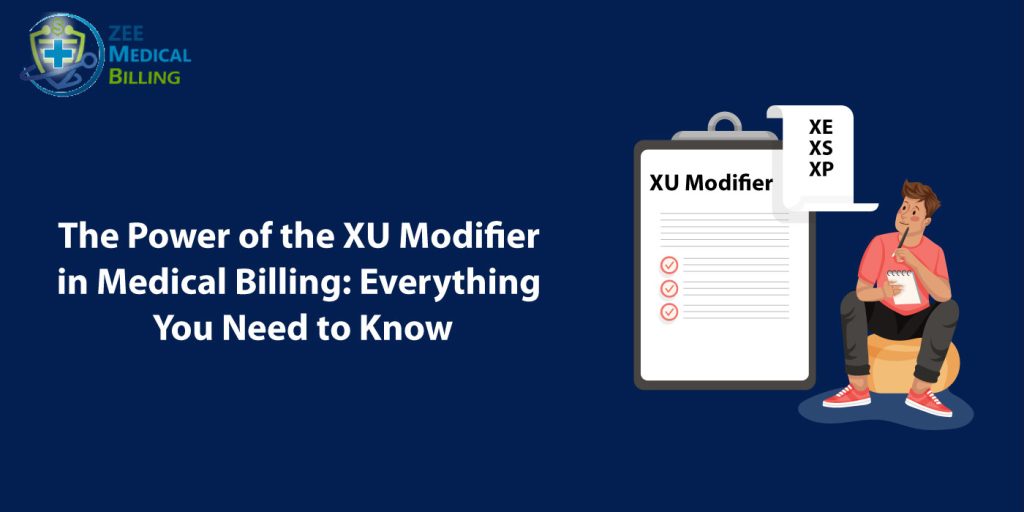The CMS (Centers for Medicare and Medicaid Services) introduces different new HCPCS modifiers. These modifiers provide more clarity about the services provided. In order to decrease the inappropriate usage of modifier 59 and help in increasing and improving the claims processing for providers, “X” subset modifiers have been introduced. The financial stability of medical practices can be considerably impacted by knowing how to use them properly. Let’s see in detail the characteristics of the XU modifier and provide in-depth knowledge for both billing experts and medical professionals.
What is the XU Modifier?
The Centers for Medicare & Medicaid Services (CMS) developed the XU modifier, which is a member of the X {EPSU} modifier family. It was designed to give more clarity in coding and to replace the often misapplied modifier 59. The XU modifier indicates that a service is unique, non-overlapping, and different from other services that are provided on the same day.
Importance of XU Modifier
Proper use of the XU modifier ensures that healthcare providers receive correct reimbursement for services that might otherwise be bundled together. It is important because this modifier clarifies the complex processes and helps in differentiating services that are separate from other billing services. It also helps in reducing denial claims because each service is clear with the right associated codes. XU modifier also ensures that you adhere to the CMS guidelines so you do not face any potential audits and penalties.
When using the XU Modifier
There are different scenarios in which you can use the XU modifier including:
- The XU modifier is mostly used to signify that a procedural service is unique because it doesn’t overlap with other services performed on the same day. For example, when a patient performs multiple operations and each has different indications and purposes then the XU modifier helps in identifying and differentiating these services.
- The XU modifier is also necessary when a service is unique and separate from another service. Like if a provider performs a diagnostic test in the morning and another separate therapeutic procedure in the afternoon, the XU modifier can be used to indicate that these are separate services.
Best Practices for Applying the XU Modifier
Detailed Documentation
When using the XU modifier, precise and thorough documentation is essential. The medical records should clearly justify the use of the XU modifier, which should show that the treatments were unique and required. This documentation is really helpful in case of an audit.
Comprehensive Coding Training
It is crucial to ensure that coding personnel receive enough training on how to apply the XU modifier. With regular training sessions and keeping yourself updated with the CMS requirements common errors can be avoided and compliance can be guaranteed. It is especially crucial to understand how the XU modifier differs from other modifiers like modifier 59.
Utilizing Coding Software
Current coding software is also helpful to ensure that the XU modifier is applied correctly. These tools often have built-in checks that identify any code problems and reduce the possibility of errors and denials.
Common Mistakes to Avoid
Most of the people in medical billing face common mistakes including:
- The overuse or misuse of the XU modifier is one of the most frequent errors. Denials of claims or audits can result from this. Use the XU modifier only in situations when the service really satisfies the requirements for being unique and non-overlapping.
- Then another common mistake is not having enough documentation to back up the use of the XU modification. Make sure that the specifics of the service rendered including its need, are documented in the patient’s medical records.
- You may face Incorrect billing issues if the XU modifier is confused with other modifiers that are similar. To use modifiers appropriately make sure you understand the definitions and particular rules for each one.
Other X Modifiers in Medical Billing:
XE Modifier:
The XE modifier stands for separate encounter and is used to show that a service is part of a separate encounter on the same day as another service. This modification is particularly useful when a patient has many appointments or treatments scheduled for the same day but at various times.
XS Modifier:
The XS stands for separate structure modifier and is used to denote that a service is provided on a separate structure from other services on the same day. This is essential in a situation when billing for procedures that involve different anatomical sites.
XP Modifier:
The XP stands for separate practitioner modifier and is used when a service was performed by a separate practitioner on the same day as another service. This modifier is used for accurately billing services rendered by different healthcare providers.
Frequently Asked Questions
XU modifier is the part of X (EPSU) modifiers introduced by the CMS to replace the commonly misused modifier 59. XU modifiers are used in a situation when the services overlap with other services performed on the same day.
The XU modifier should be used in different situations like when a procedural service is unique and separate from other services and performed on the same day. For example, a diagnostic test could be followed by an unrelated therapeutic treatment, or a number of operations with various reasons and goals could be carried out.
The X {EPSU} modifiers include XE,XS and XP modifiers. XE stands for Separate encounter and used to show the services provided in distinct encounters on the same day. XS stands for Separate structure and used to show the services provided on different anatomical sites. XP stands for Separate Practitioner and used to show services provided by different practitioners.
Incorrect use of the XU modifier can give you results in terms of claim denials, payment delays, and potential audits. Consistent misuse can also result in penalties or recoupments during audits.





